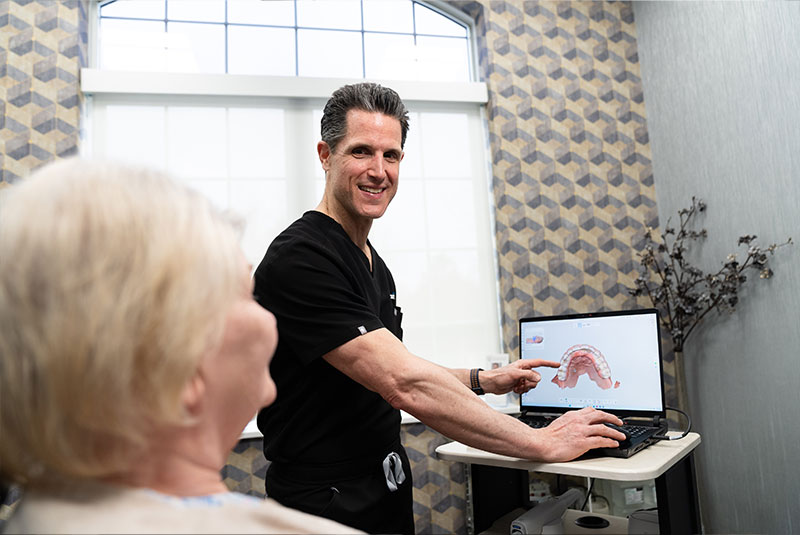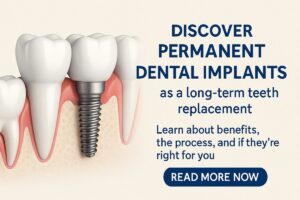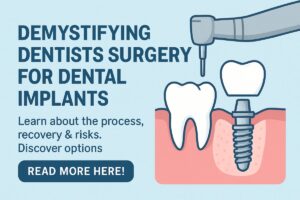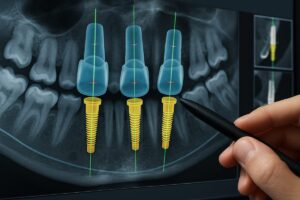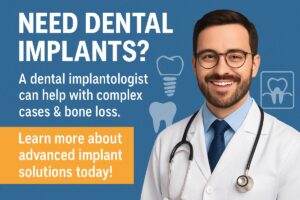This post gives a clear, simple implants definition and explains what dental implants are, the main implant types, the usual treatment steps, and when to see a specialist. By the end you’ll know the basics and the practical next steps if you think implants might be right for you.
What is a dental implant? — implants definition explained
A dental implant is a medical-grade titanium or ceramic device placed into the jaw to replace a missing tooth root. The implant acts as a stable anchor for a replacement tooth. Most implant restorations have three main parts:
- Implant body (fixture) — the part placed in the bone that integrates with the jaw.
- Abutment — the connector that links the implant to the visible tooth.
- Crown or prosthesis — the visible tooth or bridge attached to the abutment.
Unlike dentures or bridges that sit on top of gums, implants replace the tooth root and protect the jawbone by transferring chewing forces into the bone.
Common types of implants and how they differ
Endosteal (standard) implants
Endosteal implants are the most common type. They are placed directly into the jawbone and are used for single-tooth, multiple-tooth, or small bridge cases. They work well when there is enough healthy bone.
Subperiosteal implants
Subperiosteal implants sit on top of the jawbone but under the gum. They are used for patients with low bone height who cannot or do not want bone grafting. These are less common but remain an option when traditional implants aren’t possible.
Zygomatic, pterygoid, and transsinus implants
For patients told they “have no bone,” advanced options help avoid extensive grafting. Zygomatic implants anchor into the cheekbone (zygoma). Pterygoid implants anchor into the pterygoid plate behind the upper jaw. Transsinus implants cross the sinus to reach better bone. These techniques let surgeons secure full-arch restorations when the upper jaw bone is insufficient.
All-on-X and full-arch solutions
All-on-X and full-arch solutions refers to full-arch implant-supported bridges using a limited number of implants (often 4–6) to support a full set of teeth. Many practices offer same-day provisional prostheses so patients leave surgery with fixed teeth, followed by a final prosthesis after healing.
What to expect: evaluation, digital planning, surgery, and recovery
Evaluation and imaging
Good planning starts with detailed imaging. A cone beam CT scan (3D CT) shows bone quantity, nerve and sinus positions, and helps the team avoid complications. CT scans are essential for safe, precise implant placement.
Digital workflow: facial scanners, intraoral scanners, photogrammetry
Digital tools speed planning and improve fit. Intraoral scanners capture accurate impressions without messy material. Facial scanners help design teeth that match your smile and face. Photogrammetry and digital records ensure prostheses fit precisely and reduce chair time.
Surgery and immediate aftercare
On surgery day you’ll receive local anesthesia, often with sedation if requested. The implant is placed, and in many cases a temporary fixed prosthesis is attached the same day. Early recovery usually takes a few days of swelling and mild discomfort. Full bone healing (osseointegration) takes a few months, with follow-up visits for checks and adjustments before the final crown or bridge is placed. Read more about immediate aftercare.
When to see a board-certified implant specialist (and how we help)
If your case is complex — severe bone loss, prior failures, or medical concerns — seeing a board-certified implant specialist improves outcomes. Dr. Michael Fioritto is one of about nine board-certified implant specialists in Ohio and treats complex cases using advanced techniques.
At our center we place zygomatic, pterygoid, transsinus, and subperiosteal implants when patients have been told they “have no bone.” We also offer a fully digital All-on-X workflow using facial scanners, intraoral scanners, and photogrammetry to plan and deliver predictable, well-fitting prostheses.
Many patients travel from out of state. Typical workflow: meet Dr. Fioritto the day before surgery for planning, have the surgery the next day, return home the day after surgery, see the referring dentist for routine postop checks, and return months later for the final check and prosthesis delivery. We offer free consultations and CT scans to help you decide on the right plan.
Next step: schedule a free consultation and CT scan to review your case and learn if implants are a good option for you.

